In time for the Christmas market in 1899, the London publishing house of George Allen commissioned pen-and-ink illustrations for an edition of Jane Austen’s Sense and Sensibility. The illustrator’s name appeared as “Chris Hammond,” but, in fact, the artist was Christiana Mary Demain Hammond (1860–1900). Her drawings also complemented works by Goldsmith, Edgeworth, Thackeray, Gaskell, George Eliot, and others. Before her early death, Hammond completed pen-and-ink drawings for two other Austen novels, Emma (George Allen, 1898), and Pride and Prejudice (six drawings for Gresham and Company, 1900). As Devoney Looser has affirmed, Hammond’s “Austen commissions would become her most lasting artistic contribution” (66).
Chris Hammond’s life was short, but highly productive. The choices she made when illustrating Sense and Sensibility reveal the qualities of her work and underline her style, distinct from that of competitors. Furthermore, Hammond’s drawings, like Austen’s writings, have an afterlife. Tracing the journeys made by one collection points to her significance in the world of Austen and to her ongoing legacy.
![]()
Hammond’s situation, as a single woman of limited means, invites comparison with Austen’s own. Born near Brixton market in South London on 6 August 1860, Chris (as she was usually known) was the first child of Horatio Demain Hammond, a bank clerk, and Eliza Mary Hammond, née Wood. They married in Bloomsbury in 1858. It was a lower middle-class household with a modest income. Together with her sister, Gertrude (born 1862), Hammond attended the Lambeth School of Art, and both won places for free instruction at the Royal Academy schools. Chris Hammond progressed through those schools and examinations rapidly, at the same time completing commissions for periodicals.
According to Margaret Bateson, who interviewed her for a book on professional women, although she would have preferred to pursue painting commissions, Hammond decided upon pen-and-ink drawing to earn her living immediately (22). It was common to treat illustration as a genre distinct from painting (18). The Hammond sisters used each other as subjects, a convenient arrangement, since they shared a home at 2 St. Paul’s Studios, West Kensington (19). In 1898, after Gertrude married Henry McMurdie, he joined the household. Chris remained single and relied on her own labor for income. As a self-employed “jobbing professional,” she was in many ways a “New Woman” of the later nineteenth century. Such women participated in the public arena and acted independently as far they could. Unfortunately, Hammond did not enjoy the affluence that usually underpinned this model.
In Hammond’s time, men were paid higher rates for work than women, certainly for artistic efforts. Hugh Thomson, for example, had received £5 per full page drawing, £3 for half pages, and £2 for decorative tailpieces for his work on Elizabeth Gaskell’s Cranford in 1891 (Houfe, Fin de Siècle 163–64). Hammond would not have received those rates. Compared to the £150 Hugh Thomson was offered by Kegan Paul for a single book commission in the early 1890s (164), even ten years later female illustrators achieved an average annual income of only £115.1 To pursue more equitable payment, she signed herself “C. Demain Hammond” or “Chris Hammond.” (There are publications in which “Chris Hammond” is still assumed to have been male [Harman 159, index].) But from 1892, the Hammond sisters were two of Cassell’s few female illustrators for The Idler, until that journal was taken over by Jerome K. Jerome, who promptly stopped giving commissions to women (Hall). Fortunately, their services were engaged by others. Newspaper editors already familiar with Hammond’s abilities from her illustrations for serials sought her input, so she made a living. When in 1894 Henry Reichardt launched St. Paul’s Magazine, one of many contemporary illustrated periodicals, Hammond was the principal contributor of drawings to its inaugural issue. Editors of other periodicals approached her, as did the Macmillan and George Allen publishing houses.
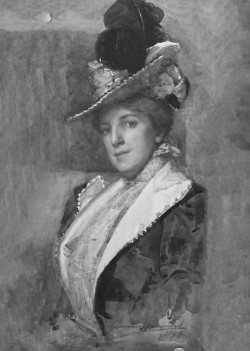
Christiana Hammond (1899), by Gertrude D. Hammond. Used with the kind permission of Canterbury Museum, New Zealand.
Thereafter she was challenged by calls upon her time, obliging her to decline commissions she could not accommodate. She completed a wide range of drawings for novels as well as for journals requiring still greater scope, and the pressure of work intensified. Not only were multiple drawings required for each novel, but editors imposed rigid deadlines. She drew sixty-four illustrations for Sense and Sensibility alone. Exhaustion resulted from such work. A few weeks before her death on 11 May 1900, Hammond inherited a small sum, probably from her father, who had died earlier that year. It might have allowed her to pursue painting commissions and reduce her novel illustration work, but it arrived too late. While the cause of death was described as unknown and unexpected, there are hints that she had contracted tuberculosis.2
In her obituary, Alfred Forman noted that “Jane Austen’s novels showed the gifted artist to the greatest advantage” and praised her as an “artist, so true and varied of insight and so strong and delicate of hand.” Hammond’s capacity for insight invites assessment. Her insight, I suggest, stemmed from applied intelligence and intuitive responses.
![]()
What stands out about Chris Hammond’s visualizations of Austen? Looser has identified Hammond’s sincerity, contrasting it with the “whimsy” of her better known competitors, Hugh Thomson and Charles and Henry Brock (62). Illustrations exhibiting sincerity require insight into narratives. Hammond applied her intellect to develop insights, before converting them into visual interpretation of texts. From previous commissions for periodicals, she had a clear indication of what met market requirements, resulting in growing demand for her services. Her pen drawings were very popular: Rudyard Kipling admired the Hammond sisters’ illustrations for one of his works, The Record of Badalia Herodsfoot (1890), a study of slum life in London’s East End, so much that he bought the originals (Bateson 20; see also Quirk, “Reconsidering Professionalism”). Looking back from 1935, English literary critic James Thorpe allowed both Hammond sisters to have been “certainly the most distinguished members of their sex in the field of illustration” (89). Another critical opinion lauds Hammond’s remarkable contributions to “the best commercial journals of the ’90s” (Houfe, Fin de Siècle 172).
The market for book illustrations grew throughout the 1890s. Increasing literacy rates after 1880 had resulted in an expanding reading audience,3 and illustrations appealed to the tastes of those buying magazines and novels. The time was right because, by the mid 1890s, interest in illustration was high: it appeared everywhere in periodicals, and art schools had seen its resurgence. This decade saw the zenith of black-and-white pen-and-ink work, before color illustrations increased in market share in the new century.
One such illustrator was Hugh Thomson, whose “light touch of the pen, observant eye and instinctive feeling for the past” were already in vogue (Houfe 163). In 1894 Thomson drew 160 illustrations for Pride and Prejudice for George Allen. Strongly resembling the look of Cranford, this “Peacock” edition was such a success that rival publisher Macmillan commissioned him to illustrate Austen’s other novels. Thomson delivered this work for Macmillan, and Hammond completed drawings for two novels in the Austen series for George Allen. The Brock brothers’ successful line illustrations, such as Charles had provided for a Macmillan edition of Pride and Prejudice in 1895, employed pen and ink before new printing techniques, pioneered in 1898 by the publisher J. M. Dent, saw the advent of the Brocks’ color-tinted drawings. Their pen line was praised as “finer” than Thomson’s, showing “more humour and aptitude for the human figure” (Houfe, Fin de Siècle 169).
How did Hammond’s style compare? It combined competent technique with a delicate touch. Because of her impressive scope, she could produce almost any magazine or novel illustration; she was not limited to representations of the past, although her pen work lent itself to “costume subjects” (Houfe, Dictionary 331). Her rivals’ pen lines were fine, but hers was also “terse”—meaning that, for a face or figure, one end of a contour line was thicker than the other, a technique that demanded a light touch but still produced subtle detail.4 Her style delivered “a spontaneous, even febrile effect” (Cooke), suggesting a state of excitement or energy in the image, and its impact was different from the nostalgic mood evoked by Thomson and the Brocks.5 Instead, Hammond’s drawings drew an emotional response. Her full-page plates and chapter header drawings for novel commissions displayed her distinct technique, effect, and emotional impact, as shown in the images discussed below.
Hammond’s drawings contained precise period detail, although her “main focus [was] on small nuances of [characters’] facial expression and gesture” (Cooke). This approach made her an excellent choice to visualize Austen’s creations. In some illustrations, she tackled the same scenes as her rivals. For instance, Hugh Thomson, Charles Brock, and Chris Hammond each produced an image for volume 1, chapter 22 of Sense and Sensibility, in which Lucy Steele and Elinor Dashwood are out walking at Barton, protected from the chill by hats and muffs.
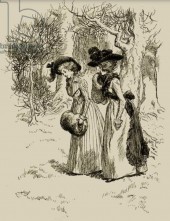 |
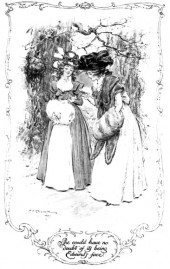 |
 |
| Vo1. 1, ch. 22. Lucy reveals her engagement, by Hugh Thomson (1896), Charles Brock (1898), and Chris Hammond (1899). (Click on each image to see a larger version.) | ||
The briefest of examinations reveals dynamic elements and indications of body language present in Hammond’s depiction but absent from her rivals’ versions. Thomson shows Lucy and Elinor conversing as they walk together; Brock uses a static pose with Elinor examining a portrait miniature of Edward while Lucy looks on. Hammond’s illustration adds movement and body language, displaying Lucy’s triumphant posture as she flourishes Edward’s letter, compelling Elinor to recognize his handwriting. Elinor draws back, aware that correspondence between Edward and Lucy confirms his commitment. The faces and bodies incline away from one another, underlining their antagonism.
Hammond drew what she imagined (or intuited) the author had in mind. She began with a close reading of the text. In her interview with Margaret Bateson she explained, “as I read, I see all the people before me, and then I draw them to illustrate the moments of the story I think most effective. But I cannot be sure that I see the author’s creations aright” (20). Hammond’s success indicates her vision or interpretation of subjects was popular and generally accepted.
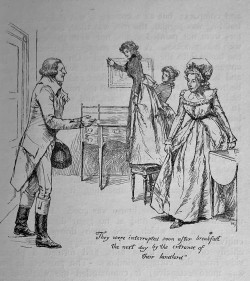
Vol. 1, ch. 6. Interrupted by Sir John Middleton (1899), by Chris Hammond.
(Click here to see a larger version.)
Where Sense and Sensibility is concerned, no modest disclaimer is necessary. Her insights into the novel, rooted in intelligent reading and intuition, are well founded. To communicate them, she selected many scenes in which characters gather, such as when Colonel Brandon visits Mrs. Jennings’s house in London in volume 2, chapter 4, or when Sir John Middleton welcomes the Dashwoods to Barton Cottage while they are settling in (vol. 1, ch. 6). Hammond’s drawings highlight Austen’s characters as they acquire fresh knowledge, so we see Margaret Dashwood telling Elinor a secret (vol. 1, ch. 12) or, later, Brandon revealing his past (vol. 2, ch. 9). Characters are presented as individuals with different stances, body language, mannerisms, and expressions, all suited to the context in which they appear. Several such elements are considered below.
As in life, body language in drawings can reveal inner feelings. For volume 1, chapter 3, Hammond draws a scene, reported after the fact in Austen’s text, in which a reluctant Edward Ferrars reads aloud Cowper’s poetry, so beloved of Marianne Dashwood. Marianne’s highly developed sensibilities are wounded by his unimpassioned delivery. As she tells her mother later, his “‘spiritless’” and “‘tame’” manner of reading with such “‘impenetrable calmness, such dreadful indifference’” was so painful to her that she “‘could hardly keep [her] seat’” (17–18). Hammond’s drawing shows how Edward’s lack of animation pains Marianne, her head and body turned away from his face and voice.
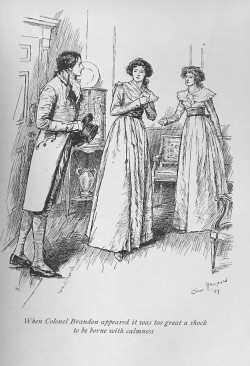
Vol. 2, ch. 4. Brandon visits in London (1899), by Chris Hammond.
(Click here to see a larger version.)
Within a single illustration, facial expressions may be supplicating, shrinking, and welcoming. It is clear from Hammond’s illustration in volume 2, chapter 4 that Colonel Brandon receives dissonant responses when he renews contact with the Dashwoods at Mrs. Jennings’s London house. While he is sincerely interested in their welfare, Marianne’s expression shows she cannot bear his not being the long-awaited Willoughby, whereas her sister, Elinor, appreciates his kindness and her outstretched hand welcomes him. Austen describes Marianne’s reaction: “It was too great a shock to be borne with calmness, and she immediately left the room” (162).
A drawing is a static medium, but Hammond created dynamic effects, including movements and emotions. An individual may be looking around, as Marianne turns while standing on her piano bench in the image for volume 1, chapter 6, (see above). Characters may see an arrival (in this example, that of Sir John Middleton) from very different physical perspectives: Elinor leans back to see past Marianne while Mrs. Dashwood looks straight ahead, with her perspective closer to Sir John’s eye level. Or there may be a rapid entrance to a room such as in volume 1, chapter 12, when the youngest Dashwood, Margaret, bursts in to disclose a secret about Marianne to an Elinor at work and whose hair has been rumpled. In technical terms, diagonal arrangements of figures and steep recessions in drawings produce the characters’ different perspectives on the same scene.
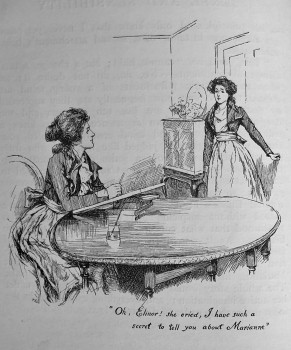 Vol. 1, ch. 12. Margaret bursts in (1899), by Chris Hammond. |
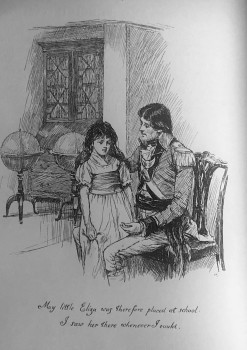 Vol. 2, ch. 9. Brandon’s past (1899), by Chris Hammond. |
Hammond’s illustrations engage and guide readers. They interpret the novel’s action, and the reader’s understanding is enriched through the artist’s acute insights. Notice Hammond’s depiction of Colonel Brandon. Through her eyes, he appears thoughtful, self-disciplined, and attractive, unlike the formal, middle-aged man drawn by the Brocks. In a tableau drawn by Hammond, he shows affection, is contemplative, but not withdrawn. Readers glimpse Brandon with little Eliza at school in volume 2, chapter 9, an image that develops his back story and extends the novel’s timeline into the past. Hammond also suggests Brandon’s affinity with children through his caring way of holding Eliza, as well as his commitment to her dead mother.
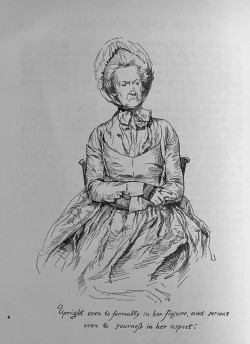
Vol. 2, ch. 12. The sour Mrs. Ferrars (1899), by Chris Hammond.
(Click here to see a larger version.)
Hammond’s approach differed particularly from Thomson’s, for he tended to depict interior, sentimental scenes. As the twentieth century began, Thomson’s approach influenced readers and stage adaptations6 of Austen’s work (Sutherland). Instead, Hammond’s wide-ranging vision contained elements that might be termed proto-cinematic. Hammond’s work presents traits of individual characters that are often developed in film adaptations. Consider her conception of the character of Mrs. Ferrars, Edward’s mother. Austen’s description is in volume 2, chapter 12: “Mrs. Ferrars was a little, thin woman, upright, even to formality, in her figure, and serious, even to sourness, in her aspect” (232). Hammond draws a thin form with a rigid face, sharp nose, and expression of contempt. As recently as 2008, a remarkably similar Mrs. Ferrars appears in Andrew Davies’s television adaptation of the novel, in which Jean Marsh plays the role with the look, hair style, and disdain that matches Hammond’s image.
An illustrator decides which characters and scenes to draw, choices that reflect the artist’s understanding of the novel. To open volume 1, chapter 5, Hammond portrays Marianne mourning her imminent departure from Norland, a beloved landscape, and for volume 2, chapter 11, another outdoor setting, where John Dashwood inspects land near Norland with a view to purchase. In the novel, John tells Elinor, “‘The land was so very desirable to me in every respect’” (225), and the artist has underscored his avarice by displaying his scrutiny of the land. Hammond portrays John Dashwood’s desire to accumulate wealth by showing it at work. Her illustration stresses the contrast between his privileged situation and the financial predicament faced by his (half) sisters.
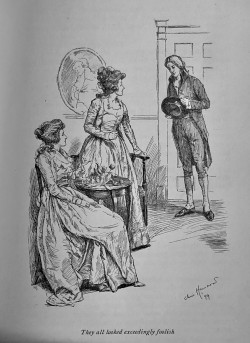
Vol. 2, ch. 13. “They all looked exceedingly foolish” (1899), by Chris Hammond.
(Click here to see a larger version.)
Hammond excelled at presenting a dramatic climax. In volume 2, chapter 13, in a scene Austen executes brilliantly in words, Elinor, Lucy Steele, and Edward confront each other. The artist employs stance, expression, and placement to show Elinor rising to do her duty as hostess; Lucy Steele seated, determined on remaining to claim Edward; and Edward trapped in a highly embarrassing three-way encounter. “They all looked exceedingly foolish” (240). Hammond’s image juxtaposes characters in a proto-cinematic vision of this scene. In volume 3, chapter 10, her illustration provides a director’s angle on Marianne climbing slowly upstairs, digesting Elinor’s disclosure of Willoughby’s dash to Cleveland, while Elinor stays downstairs to bring Mrs. Dashwood up to date. A further emotional ordeal challenges Edward in volume 3, chapter 12, as he explains about the new Mrs. Ferrars. Hammond mirrors Austen’s symbolism in the text. She depicts Edward’s cutting free, slicing the sheath for a pair of scissors, no longer honor-bound to Lucy.
The sustained attention paid to Thomson and the Brocks has not been extended to Hammond, a professional woman competing against men who have been afforded greater respect.7 Only a handful of commentators has acknowledged Chris Hammond’s legacy. Prior to Looser’s assessment noted above, Brian Southam praised her “decisive and characterised pen-and-ink drawings” for being “neither whimsical nor over-decorative,” deeming her the finest artist of the period (51ff). Hammond’s interpretations have earned admiration because of the ways they enhance the reader’s experience. In some cases, as when she endowed Colonel Brandon with physical appeal and presented an unflinching treatment of Mrs. Ferrars, John Dashwood, and others, she also anticipated today’s readings of characters.
![]()
In art and literature, an early death may cause a surge of acclaim, but in time, awareness of achievements can decline. The Austen editions Hammond illustrated retained their value, and those inside her circle kept her memory alive, but recognition of her professional qualities was vested in well-informed enthusiasts only.
Hammond’s original drawings have been dispersed around the world. The original drawings for Austen’s novels were split up for sale before the 1940s, when the Morgan Library received a bequest that included seven such drawings: one illustration from Emma and six from Sense and Sensibility. A sales catalog accompanying the bequest supplied provenance for the drawings, listing them in its pages. Alberta Burke had purchased them at the sale, and subsequently they joined the Morgan Library’s extensive collection (Williamson 13). Meanwhile, twelve original illustrations for Sense and Sensibility and one other by Hammond crossed the world to New Zealand, where they lay undisturbed for decades. In October 2016, Peter and Sandra Moffatt of Nelson, New Zealand, found original drawings they could not identify in their family archives. One such illustration was dated “’99” and signed “Chris Hammond.”
In search of information about the illustrations, the Moffats emailed Laurel Ann Nattress of the Austenprose website, who informed them that twelve of their thirteen Hammond drawings had been created for an 1899 edition of Sense and Sensibility. (The other drawing depicted a scene from Stanley J. Weyman’s Sophia [Longmans, 1899].) The Moffatts examined a copy of the book and found the printed versions of the drawings. Exactly how they came to New Zealand is uncertain.
Peter Moffatt’s grandmother, Ethel Jane Moffatt (1893–1970), was a scholar and the family archivist. To Peter Moffatt’s sister, Pip Taylor, Ethel Moffatt had bequeathed a self-portrait by Gertrude Hammond. In an annotation, Ethel confirmed her ownership. Ethel had also made many donations to the Canterbury Museum in Christchurch, New Zealand. In July 2021 the Moffatts visited the museum to view two of those donations. First, they saw an original portrait of Christiana Hammond painted by her sister, Gertrude, fully realized, unlike Cassandra Austen’s well known but unfinished sketch of her sister, Jane. The color portrait of Hammond (shown earlier in this essay) dated from 1899, when she was still working on Austen-related commissions. The subject is dressed for a formal occasion, wearing an eye-catching feather-adorned hat. The portrait celebrates a woman who might have stepped out from one of her illustrations depicting the world of Austen.
The second item the Moffatts found at the Canterbury Museum was a memorial booklet containing Hammond’s obituary. On the back was Ethel’s handwritten note: “For Dick from Gertrude McMurdie, Worthing, June 1935. Mrs. McMurdie painted the portrait of her sister, Miss Christiana Demain Hammond; it to be exhibited in the Canterbury Museum’s Pilgrims’ Galleries.” Ethel’s record confirms a link between the Hammonds and Moffatts. The portrait of Chris Hammond remains in New Zealand.
Earlier, the Moffats had also contacted Jane Austen’s House in Chawton and were delighted when (then) Director Mary Guyatt expressed keen interest. In 2018, they took their drawings for Sense and Sensibility to Chawton. There was a warm welcome at Jane Austen’s House and these original illustrations became part of its extensive collection of artifacts.8 Chris Hammond’s Austen-related drawings, displaying much sense and sensibility, have global distribution. They, and the editions she illustrated, remain treasures more than a century after her death because, as a contemporary wrote, she “occupies a place of assured distinction among illustrators” (Bateson 19).
NOTES
1Welfare campaigner Emily Hobhouse estimated in 1901 that the average woman artist earned only £115 per year. This income level was equivalent to that of bank clerks (like Hammond’s father), curates, and telegraphists and, if the female artist’s only income came from such work, was barely on the threshold for middle class earnings (Quirk, Women vii).
2Gertrude Hammond, via Ethel Moffatt, appears to be the source of the information that her sister died of tuberculosis.
3The Education Act 1880 made school attendance compulsory between the ages of five and ten in the UK. By the early 1890s, school attendance for this age group had reached 82 per cent. The reading market continued to grow.
4This definition of “terse” as it applies to art is also used by Gary Martin (Glossary 1).
5Cinthia García Soria refers to a “chocolate box” style associated with illustrations by Thomson and the Brocks, citing lavish illustrations and handsome bindings.
6Kathryn Sutherland commented on the influence of illustrations on turn-of-the-century stage audiences in “What Makes a Good Austen Adaptation?” Among other topics, she discussed several pen-and-ink drawings for illustrated editions of Austen’s novels in the 1890s.
7Laurel Ann Nattress notes Hammond’s brief career affected how well known she remained after her early death.
8I reported the rediscovered drawings from a New Zealand perspective for JASA’s Chronicle, and Sophie Reynolds, Collections Manager at Jane Austen’s House, obtained my commentary for their Hammond exhibits. See also “Illustrations by Chris Hammond for Sense and Sensibility” on the Jane Austen’s House website.
